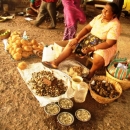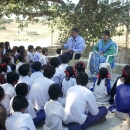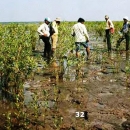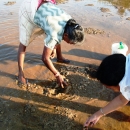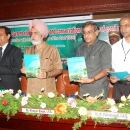Grants :: Small Grant Facilities :: A critical evaluation of the impacts of alternative livelihood programmes to reduce dependence on the Sundarbans mangroves
A critical evaluation of the impacts of alternative livelihood programmes to reduce dependence on the Sundarbans mangroves
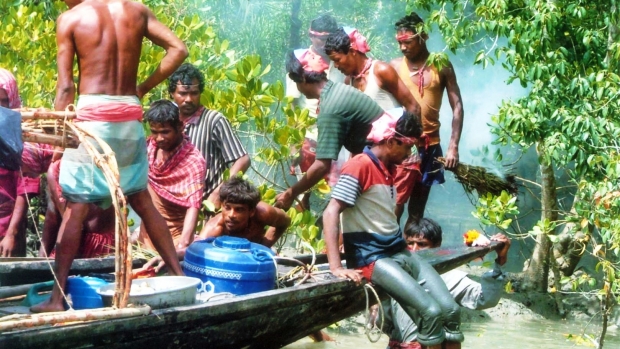
Honey Colletors team in Sundarbans, West Bengal, India © Pradeep Vyas, 2007
Objectives
The Sundarbans SGF project set out to evaluate the impacts of livelihoods interventions aimed at reducing local dependence on forests. It looked at eco-development activities, infrastructure and agricultural development, afforestation, soil conservation, protection of embankments and mangrove planting. The project also sought to evaluate and rate confidence-building activities in community development projects, and to evaluate different alternative and sustainable development initiatives.
Background
The Sundarbans is one of the largest mangrove ecosystems in the world, covering an area of 9,400 km2. Its 4.2 million inhabitants are unevenly distributed with a high population density of 800 people/km2, generating considerable anthropogenic pressure on the ecosystem. The Sundarbans Forest Department launched this project to review past livelihood interventions and recommend priority areas for funding to develop alternative, eco-friendly livelihoods that will balance biodiversity conservation with human development. The methods used included questionnaire surveys, focus group discussions, physical verification of assets and the analysis of secondary data from Gram Panchayats (local village councils) on infrastructure and facilities in the targeted villages.
Target beneficiaries
Joint Forest Management (JFM) members, Forest Protection Committees (FPCs) and Eco-Development Committees (EDCs). These organizations all include women as members.
Outputs
- A comprehensive analysis of past activities and programmes undertaken by the Sundarbans Forest Department in 50 village JFM Committees and their effectiveness under the Alternative Livelihoods Programme.
- Recommendations for improving the relationship between the Forest Department and local people – a relationship that is critical for long-term conservation of the Sundarbans ecosystem.
- Recommendations for successful alternative livelihood interventions that will be needed to address conservation and livelihoods needs in the long run.
- An evaluation of past and present livelihoods projects to address the increasingly important issue of climate change adaptation.
Accomplishments and challenges
A detailed report on biodiversity-dependent local livelihoods has been submitted to the Forest Department, including baseline data and trends in fishing (legal and illegal), wood gathering and honey collection over the past three decades. The project found that infrastructure development (wells, jetties, solar lighting and so on) has had a positive impact on the alternative livelihoods promoted in the region, so it should be a key element in any future discussion on alternative livelihoods. The project also highlighted the need to develop disaster risk reduction strategies for biodiversity-dependent villages. The Forest Department has agreed to maintain and update the information database, ensuring sustainability of project outputs. The success of confidence-building measures between the Forest Department and local communities has lessened human-wildlife conflict. Local people now report straying wild animals and trust the Forest Department to take appropriate action.
Challenges
Cyclone Aila struck West Bengal in 2009, causing delays in project implementation. In some cases it also affected the questionnaire surveys, as answers tended to be “Alia-biased” and unrepresentative of “normal” conditions. Framing survey questions proved challenging as each stakeholder group had many sub-groups (for example “fishers” include marine fishers, freshwater fishers, crab collectors and so on), each usually with different competing needs and interests. In view of the dynamic nature of the ecosystem, climate change and human societies, it was recommended that all future alternative livelihoods projects should be limited to three years to be meaningful.
Contributions to cross-cutting themes
Mangroves are increasingly being recognized for their protective functions. The Sundarban mangroves in particular provide many services that the local communities directly benefit from. However, in order to ensure the long-term benefit of these services requires that some of the pressures on the ecosystem be reduced.
Lessons Learned
Cyclone Aila struck West Bengal in 2009, causing delays in project implementation. In some cases it also affected the questionnaire surveys, as answers tended to be “Aliabiased” and unrepresentative of “normal” conditions. Framing survey questions proved challenging as each stakeholder group had many sub-groups (for example “fishers” include marine fishers, freshwater fishers, crab collectors and so on), each usually with different competing needs and interests. In view of the dynamic nature of the ecosystem, climate change and human societies, it was recommended that all future alternative livelihoods projects should be limited to three years to be meaningful.
Project Facts
Country
Location
Sundarbans, West Bengal, India
Topic
Duration
7th Dec 2008 to 31st Aug 2009
MFF Grant Amount
US$ 10,000
Co-financing Partner
WWF Bengal conducted the village surveys under the project.
Implementing Partner
Mr Pradeep Vyas
Director
Sundarbans Biosphere Reserve
Forest Department, Government of
West Bengal, Bikash Bhawan, 3rd
Floor, North Block, Salt Lake City,
Kolkata 700 091, India
Tel: +91 33 248 4288829
Email: pradeepvyas@gmail.com

